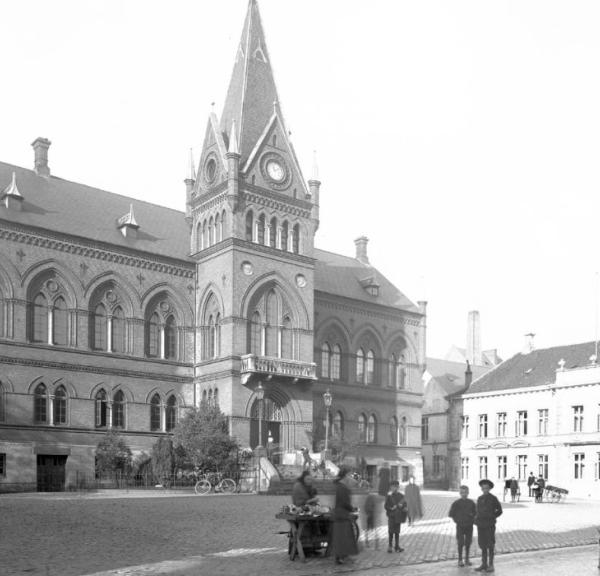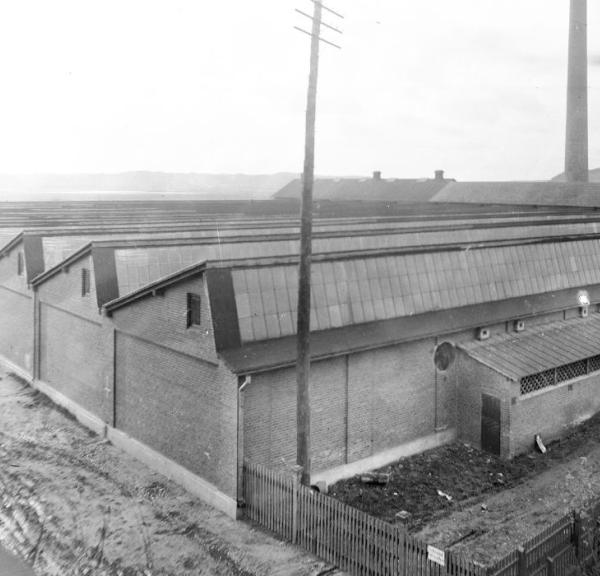
The History of Vejle
Vejle was first mentioned in 1256, but its history is believed to be even older. Excavations south of Kirketorvet have revealed settlements dating back to the year 1100. The oldest known market town privileges were granted in 1327.
From Ford to Industrial Town
Vejle means "ford" and was the name given to the settlement built on a small island in the middle of Vejle Ådal, where the Grejs River meets the Vejle River, just before it flows into the fjord.
The southern side of the island, around Søndergade, was the first to be built, and later the town expanded to the north. Vejle was completely surrounded by watercourses: the two branches of the Grejs River with Omløbsåen to the west and Mølleåen to the east. To the south, Sønderåen formed the boundary, and to the north, Midtåen.
The Oldest Vejle and Its Citizens
The town's citizens were merchants and craftsmen. The rivers and fjord provided a livelihood for a group of fishermen, and as the town grew, farming became an important occupation for the citizens, serving the local hinterland.
Vejle's oldest surviving building is Sct. Nicolai Church from the mid-13th century. It is located east of the town’s main streets: Søndergade, Rådhustorvet, Torvegade, and Nørregade. Excavations in Klostergade suggest that Vejle had an older church on the town's highest point, before the Dominican monks built a monastery here around 1310.
Vejle Mill was established in the 1200s with a more than 700-meter-long mill canal (Mølleåen) and an accompanying dam to the east. The town also had another canal, Midtåen. These two canals served as a fortification for Vejle. The street name Borgvold tells us about the King's castle, Castrum Wæthel, which was located where the bus station is today.
During the 1400s, Vejle expanded beyond its old northern boundary, with houses built along the current Nørregade. Midtåen lost its significance as a fortification and gradually shrank from about 20 meters wide to 1-2 meters. In the same period, the king's castle was dismantled.
The Small Town – Plague and Competition
In the 1500s and into the 1600s, Vejle, like many other market towns, experienced prosperity and growth. Vejle participated in the increasing export of cattle and traded with merchants from Flensburg, Lübeck, and elsewhere.
By the mid-1500s, Vejle had about 1,500 inhabitants. In 1584, the plague reduced the population by one-third, and the 1600s, with its many wars, was a difficult time for the town. In 1654, Vejle narrowly avoided losing its market town status to Fredericia.
Competition from neighboring towns was fierce, and Vejle struggled economically. It wasn't until the late 1700s that development picked up again. By 1800, Vejle was still a small and insignificant market town with a rural character. Between the first census in 1769 and 1801, the population grew from 967 to about 1,300 people.
Harbor, Railway, and Development
In 1827, a brand-new harbor was inaugurated east of the town, laying the foundation for further development of Vejle's industry. In 1868, the town was connected to the railway, becoming a station on the main Jutland line. With the establishment of two private railways, Vejle-Give in 1894 and Vejle-Vandel in 1897, the town opened up to the western hinterland. During this period, Vejle also gained other service institutions, such as a gasworks, water supply, and telephone services.
From Market Town to Industrial Town
In 1850, Vejle had about 3,300 inhabitants, but by the turn of the century, the population had grown to about 14,600. This rapid expansion was due to the town’s transformation from a market town into an industrial hub, particularly in the iron and textile industries. Major companies included P. Jensen & Co. Iron Foundry (1862), C.M. Hess Iron Foundry (1876), Vejle Bolt and Nut Factory (1899), and Vejle Cotton Mills (1892 and 1904).
In the late 20th century, new industries, such as the food and beverage sector, took the lead with companies like Tulip and Dandy. In recent decades, the information and communication industries have also emerged, characterized by a range of small and medium-sized businesses.
Culturally, Vejle is well-equipped with institutions like the Torvehallerne and the Music Theatre, opened in 1992/93, and the Spinderihallerne complex, a former industrial site now home to entrepreneurs, artists, local associations, and the Cultural Museum.
Housing and Infrastructure
The need for housing was initially met by building in unoccupied areas, utilizing backyards, and adding extra floors to existing buildings. In the 1890s, a new working-class neighborhood began to take shape in the western part of the town, while prominent businessmen built villas in Mølholm to the south.
The growth of the town led to increasing traffic pressure. Over time, new streets were laid out, Mølleåen was piped in the 1930s, and the Vejlefjord Bridge opened in 1980. From the 1990s onward, significant renovations took place in the city center.
Political Landscape and Population Growth
Politically, Vejle has long been a stronghold of the labor movement and the Social Democrats. However, since 2007, the town has been governed by other parties, with Jens Ejner Christensen of the Liberal Party serving as mayor since 2017.
During the 2007 municipal reform, Vejle merged with neighboring municipalities. Today, Vejle Municipality has about 115,000 inhabitants, with approximately 57,000 living in the town of Vejle.







